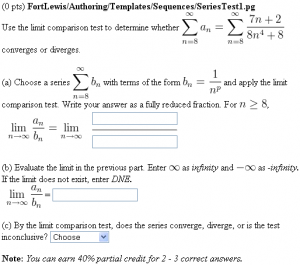SeriesTest1
Requiring Students to Justify Series Tests
This PG code shows how to require students to justify series tests.
- Download file: File:SeriesTest1.txt (change the file extension from txt to pg when you save it)
- File location in NPL:
FortLewis/Authoring/Templates/Sequences/SeriesTest1.pg
| PG problem file | Explanation |
|---|---|
|
Problem tagging: |
|
DOCUMENT(); loadMacros( "PGstandard.pl", "MathObjects.pl", "unionTables.pl", "parserPopUp.pl", "PGgraders.pl", "parserMultiAnswer.pl", ); TEXT(beginproblem()); |
Initialization:
We load |
Context("Numeric")->variables->are(n=>"Real");
$a = random(2,9,1);
$b = random(2,9,1);
$c = random(5,20,1);
$d = random(3,9,1);
$e = random(2,9,1);
$dm1 = $d - 1;
$dm2 = $d - 2;
# TeX
$series = "\sum_{n=$c}^{\infty} \frac{$a n + $b}{$c n^{$d} + $e}";
$fraction = "\lim_{n\to\infty} \frac{a_n}{b_n} = \lim_{n\to\infty}";
$num1 = Formula("$a n^$d + $b n^$dm1");
$den1 = Formula("$c n^$d + $e");
$num2 = Formula("$a + $b/n");
$den2 = Formula("$c + $e/(n^$d)");
$multians = MultiAnswer($num1, $den1)->with(
singleResult => 0,
checker => sub {
my ( $correct, $student, $ansHash ) = @_;
my ( $stu1, $stu2 ) = @{$student};
if (($num1 == $stu1 && $den1 == $stu2) ||
($num2 == $stu1 && $den2 == $stu2) ) {
return [1,1];
} elsif (($num1 == $stu1 && $den2 == $stu2) ||
($num2 == $stu1 && $den1 == $stu2)) {
$ansHash->setMessage(1,"Check your algebra");
$ansHash->setMessage(2,"Check your algebra");
return [0,0];
} elsif ($num1 == $stu1 || $num2 == $stu1) {
return [1,0];
} elsif ($den1 == $stu2 || $den2 == $stu2) {
return [0,1];
} else {
return [0,0];
}
}
);
$limit = Formula("$a/$c");
$popup = PopUp(["Choose","Converges","Diverges","Inconclusive"],"Converges");
#
# Display the fraction and answer blanks nicely
#
Context()->texStrings;
if ($displayMode eq 'TeX') {
$showfraction =
"\[ $fraction ".$multians->ans_rule(10).$multians->ans_rule(10)." \]";
} else {
$showfraction =
ColumnTable(
"\( \displaystyle $fraction \)",
$multians->ans_rule(20).$BR.$HR.$multians->ans_rule(20),
indent => 0, separation => 10, valign => "MIDDLE"
);
}
Context()->normalStrings;
|
Setup:
We use the MultiAnswer object
We display the answerblanks nicely as a fraction in HTML and TeX modes by how we constructed |
Context()->texStrings;
BEGIN_TEXT
Use the limit comparison test to determine whether
\( \displaystyle \sum_{n=$c}^{\infty} a_n = $series \)
converges or diverges.
$BR
$BR
(a) Choose a series \( \displaystyle \sum_{n=$c}^\infty b_n \)
with terms of the form \( \displaystyle b_n = \frac{1}{n^p} \)
and apply the limit comparison test.
Write your answer as a fully reduced fraction.
For \( n \geq $c \),
$showfraction
$BR
(b) Evaluate the limit in the previous part. Enter \( \infty \)
as ${BITALIC}infinity${EITALIC} and \( -\infty \)
as ${BITALIC}-infinity.${EITALIC} If the limit does not exist,
enter ${BITALIC}DNE.${EITALIC}
$BR$SPACE
\( \displaystyle \lim_{n\to\infty} \frac{a_{n}}{b_{n}} \, \) =
\{ ans_rule(20) \}
$BR
$BR
(c) By the limit comparison test, does the series
converge, diverge, or is the test inconclusive?
\{ $popup->menu() \}
END_TEXT
Context()->normalStrings;
|
Main Text: |
$showPartialCorrectAnswers=1;
install_problem_grader(~~&custom_problem_grader_fluid);
$ENV{'grader_numright'} = [2,4];
$ENV{'grader_scores'} = [0.4,1];
$ENV{'grader_message'} = "You can earn " .
"40% partial credit for 2 - 3 correct answers.";
ANS( $multians->cmp() );
ANS( $limit->cmp() );
ANS( $popup->cmp() );
|
Answer Evaluation: We use the problem grader fluid to give partial credit incrementally: 0% for 0-1 correct answers, 40% for 2-3 correct answers, and full credit for 4 correct answers. |
Context()->texStrings;
BEGIN_SOLUTION
${PAR}SOLUTION:${PAR}
Solution explanation goes here.
END_SOLUTION
Context()->normalStrings;
COMMENT('MathObject version.');
ENDDOCUMENT();
|
Solution: |
